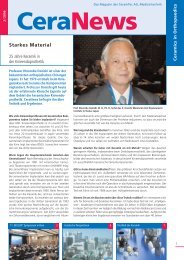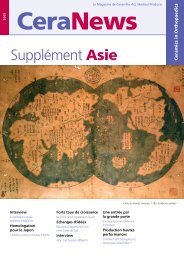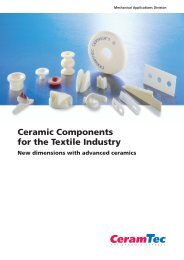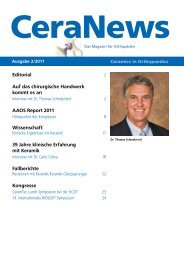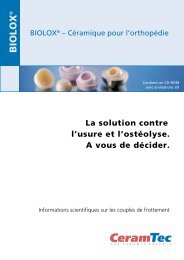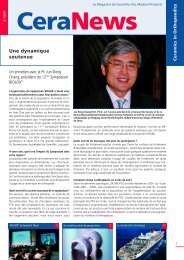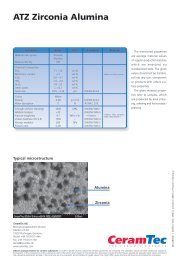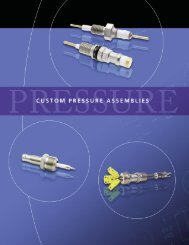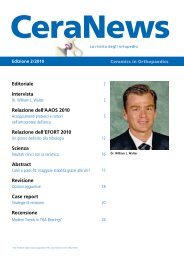Download PDF, 2.4 MB - CeramTec
Download PDF, 2.4 MB - CeramTec
Download PDF, 2.4 MB - CeramTec
You also want an ePaper? Increase the reach of your titles
YUMPU automatically turns print PDFs into web optimized ePapers that Google loves.
ScienceWhat’s New in Hip Arthroplasty?Advantages and long-term results of CoC THAExperts discussed clinical outcomes of CoC THA at the SICOT, ISTA, SOFCOTand SIOT congresses 2011.Laurent Sedel (France) reported on advantages of ceramic bearings and hisclinical results of alumina CoC THA with an overall survivorship of 88% at 20years. Ceramic bearings have demonstrated the lowest in-vivo wear rates todate of any bearing combination. They have an excellent biocompatibility, abetter wettability and a greater hardness than metal.The advantages of ceramic-on-ceramic are great. This coupledoes not present any biological adverse effects, no allergicresponse, no elevation of chromium or cobalt in the blood andno problems regarding pregnancy or renal insufficiency.10-year results with CoC THA- Laurent Sedel, MDIn: Researchers tout the advantages of ceramic-on-ceramic hip bearings.ORTHOSuperSite; http://www.orthosupersite.com/view.aspx?rid=90278Delta ceramic has especially gained increasing use asimprovement of the ceramic material allows larger femoralheads and reduces the risk of ceramic fracture dramatically.Prof. Sedel’s data are stimulating the use of this hard-on-hardbearing articulation, which is now accepted worldwide asmaterial with optimal wear characteristics to achieve excellentlong-term clinical results.- Karl Knahr, MDIn: Researchers tout the advantages of ceramic-on-ceramic hip bearings. Perspective.ORTHOSuperSite; http://www.orthosupersite.com/view.aspx?rid=902786–11-year results with CoC THAJérôme Essig et al. (France) reported on clinical andradiographic results of 232 consecutive cementlessalumina CoC THA (BIOLOX ® forte) in 224 patients.The mean age was 58 (22–78) years. A 28mm femoralball head was used in 99% of all cases. Indicationswere osteoarthritis (81%) and osteonecrosis(13%). The mean follow-up was 9.2 (6–11) years.Squeaking was noted in 16 patients (6%) and disappearedin 10 patients. 6 hips were revised. Patientshad to be revised for septic loosening (4), periprostheticfracture (4) and dislocation (1). Ceramic fractureswere not observed. No acetabular or femoralosteolysis could be detected at the latest follow-up.The survival rate was 96.6% at 10 year follow-up,revision for any reason taken as endpoint.This series shows that alumina CoC THA in youngand active patients avoids the risk of osteolysis andimproves implant longevity, the authors concluded.3-year results with larger CoC THASuk Kyu Choo et al. (Korea) evaluated clinical andradiographic results of 43 CoC THA (BIOLOX ® forte,BIOLOX ® delta) in 40 patients. The average age was56 (28–82) years. The indication was osteonecrosisin 21 cases. A 36mm femoral ball head was used.The minimum follow-up was 3 years. Squeaking wasobserved in 3 patients. The authors reported that 1patient had a dislocation after an accident one weekafter surgery. There was no ceramic fracture.No osteolysis or aseptic loosening could be observedat the latest follow-up.Cementless CoC THA – More stabilitywith screws?Simon Tilley et al. (Australia) evaluated the clinical and radiographic outcomeof 120 consecutive alumina CoC THA (BIOLOX ® forte) in 110 patients. Theaverage age was 45 (20–55) years. 4 patients died and 6 were lost to followup.There were no postoperative ceramic fractures. There was an intraoperativeceramic liner chipping in 1 case. The authors reported that the liner waschanged without any complication. Squeaking was reported in 2 cases.No acetabular or femoral osteolysis could be observed at the latest follow-up.Wear rates were undetectable. The survival rate was 97.5% at 10 year followup,revision for any reason taken as endpoint.Alumina ceramic-on-ceramic bearings in cementless primaryTHA in this series have resulted in good clinical and radiographicoutcomes with low wear rates and excellent function in thedemanding younger patient group at 10 years.* Jäger M et al. Migration pattern of press fit cups in the presence of stabilizing screws.Abstract F 240, EFORT, Madrid, 2–5 June 2010- Simon Tilley, MDIn the 2/2010 issue of CeraNews we reportedon findings of a prospective study by a Germanresearch group * confirming that the stabilityof pressfit cups is not enhanced by the use ofscrews.Now, Christophe Chevillotte et al. (France) presented10-year results of 51 CoC THA without screwfixation and 49 CoC THA with the use of screwfixation. The aim of this retrospective study was toevaluate acetabular implant migration, osteolysis,radiolucent lines and ossifications in order to answerthe question whether screws are useful for the fixationof the acetabular component in cementless primaryCoC THA. Patient demography and implantsizes were comparable. The clinical and radiographicresults in this series did not show any superiority ofthe screw fixation of pressfit cups (p>0.05).The authors concluded that a ceramic-on-ceramicbearing can be used reliably with a pressfit fixationwithout additional screws.CeraNews 1/20125



